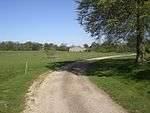Sir Mordaunt Martin, 4th Baronet
| Sir Mordaunt Martin, 4th Baronet | |
|---|---|
| Baronet | |
 Coat of arms of the Martins of Long Melford. Argent, a chevron between three mascles Sable within a bordure engrailed Gules. The red hand on an escutcheon signifies the arms of a baronet | |
| Born | 1740 |
| Died | 24 September 1815 |
| Noble family | Martin of Long Melford |
| Spouse(s) |
Everilda-Dorothea Smith Catherine Styleman |
|
Issue
Sophia Elizabetha Martin Everilda-Dorothea Martin Mordaunt Martin Anna-Maria Martin Louisa Mary Ann Martin Mordaunt Martin Caroline Martin Frances Martin Sir Roger Martin, 5th Baronet Catherine Martin | |
| Father | Sir Roger Martin, 3rd Baronet |
| Mother | Sophia Mordaunt |
Sir Mordaunt Martin, 4th Baronet (c. 1740 – 24 September 1815) was son of Sir Roger Martin, 3rd Baronet and Sophia Mordaunt. He inherited his baronetcy from his father, who was the third Martin Baronet, upon his death in 1762. He lived in Burnham Market in Norfolk
Career

Sir Mordaunt was a marshall of the vice admiralty court in Jamaica.
In 1808 he purchased Burnham Westgate Hall, which he built onto. In particular he built a number of farm buildings. A keen agriculturalist, he wrote many letters and articles on the relative benefits of the mangel wurzel as a crop and is documented as the first person to introduce the plant, as well as sainfoin to the county and greatly improved the growth of potatoes and other vegetables. On his death he left the hall-described by White as "a hand-some mansion, beautified with pleasure grounds and shrubberies, and situated near the church", to his son and heir Roger
The Gentleman's Magazine, Obituary; with anecdotes of remarkable persons, 25 September 1815
Personal life
On 29 July 1765 [1] Sir Mordaunt married Everilda-Dorothea Smith (1743 – 21 September 1800), daughter of the Reverend William Smith rector of Burnham Market and by her had three sons and seven daughters:
- Sophia Elizbetha Martin (c. 1766 – 18 November 1827), died unmarried.
- Everilda-Dorothea Martin (5 June 1767 – 27 November 1839), married Rev. Thomas Bernard and by him had five sons.
- Mordaunt Martin (February 1769 – 25 November 1769), died an infant.
- Anna-Maria Martin (c. 1770 – 1853), married Rev. John Glasse rector of Burnham.
- Louisa Mary Ann Martin (baptised 20 August 1771)[2] married Captain Isaac Wolley, RN.
- Mordaunt Martin (baptised 29 October 1772 - buried 10 June 1773), died an infant.[3]
- Caroline Martin (1773 – 3 June 1848), married Rev. James Monroe of Monken Hadley in Middlesex and by him had one son.
- Frances Martin (c. 1775 – 27 July 1802), died unmarried.
- Sir Roger Martin, 5th Baronet (22 February 1778 – 15 December 1854), married Mary Ann Clark and was without issue.
- Catherina Martin
Governess to these children from 1775 to 1780 was a very young Jane Arden, the first friend of Mary Wollstonecraft. She later set up a school and published educational works as Jane Gardiner. She named her daughter Everilda, after Lady Martin. Governesses were often isolated and oppressed,[4] but the Martins treated her well – on a return visit, "more as a daughter than as an humble 'gouvernante'". She commented that the family atmosphere was intellectual, refined, and Christian.
Burnham was within visiting distance of Houghton Hall, then in the possession of Horace Walpole; the Martins took their former employee to admire the famous collection of paintings there.[5]
Sir Mordaunt remarried on 4 August 1808 to Catherine (21 July 1759 – 29 April 1825), daughter of Rev. Armine Styleman and widow of Rev. Edward North, with whom he had no children and who survived him. He died on 24 September 1815, when his title passed to his eldest son. Sir Mordaunt was buried in Burnham Westgate Church with his first wife Everilda-Dorothea.
References
- ↑ Marriage Register, Burnham Westgate
- ↑ Register of Baptisms, Burnham Westgate
- ↑ Parish Registers, Burnham Westgate
- ↑ Porter, Anne (1998). A Governess in the Age of Jane Austen: The Journals and Letters of Agnes Porter. A&C Black.
|access-date=requires|url=(help) - ↑ Gardiner, Everilda Anne (1842). Recollections of a Beloved Mother. Londpn: W. McDowall.
|access-date=requires|url=(help)
- Burke, John (1838), A genealogical and heraldic history of the extinct and dormant baronetcies of England, Microform Ltd., p. 439
- Debrett, John; Collen, George William ed. (1840), The baronetage of England. revised, corrected and continued, Oxford University, p. 373
- Debrett, John; Courthorpe, William ed. (1839), The baronetage of England, J. G. & F. Rivington, p. 130
- Burke, John; Courthorpe, William ed. (1832), A General and heraldic dictionary of the peerage and baronetage of the British Empire, 2, H. Colburn and R. Bentley, p. 147
- Hervey, William, Clarenceux king of arms (1866), The visitation of Suffolke, Lowestoft, London: S. Tymms, Whittaker and co., pp. 230–231
- Burnham Westgate Church – Monument Inscriptions, Burnham Westgate: burnhammarket.co.uk, pp. 45–50, archived from the original on 18 January 2013
- St John Priest, Richard Parkinson (1813), General view of the agriculture of Buckinghamshire, Sherwood, Heeley & Jones, p. 219
- White, William (1854), History, gazetteer, and directory of Norfolk, and the city and county of the city of Norwich, R. Leader, p. 665
- Churchill, Penny (2011), An exceptional country estate in Norfolk, retrieved 30 January 2012
- Nicholls, John (1815), The Gentleman's magazine, 118, E. Cave, p. 379
- Matcham, Mary Eyre (1911), The Nelsons of Burnham Thorpe: A record of a Norfolk family compiled from unpublished letters and notebooks, London: John Lane, pp. 163–168
- Jones, Elizabeth, Reminiscences of Elizabeth Jones (nee Helsham, 1801–1866), retrieved 31 January 2012
| Baronetage of England | ||
|---|---|---|
| Preceded by Roger Martin |
Baronet (of Long Melford) 1762–1815 |
Succeeded by Roger Martin |